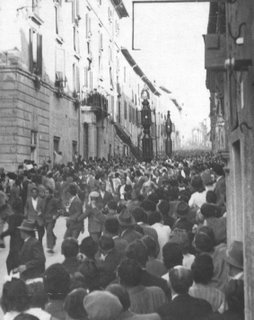
The Lilly Brothers, John Henry.
Bill Clifton and His Dixie Mountain Boys, Mary Dear.
By the late 1950s, bluegrass, once country music's conservative wing, had begun to slowly evolve into a brand of international folk music. Continuing a process that had begun in country music, ancient blues or folk tunes were cleaned up and often deracinated, becoming folkie standards in places far from the music's origins.
Take the Lilly Brothers. Everett and Mitchell (known generally as "B" or "Bea") were born in Clear Creek, West Virginia, and began playing the regional circuit in the 1930s, inspired by the Carter Family and the Monroe Brothers. B played guitar, Everett sang and played mandolin (and worked for Flatt & Scruggs for a time). But in 1952, the brothers and other players like banjoist Don Stover and fiddler Tex Logan moved northward, where they became the house band at the Hillbilly Ranch, located in Boston, "where they attained a following from the intellectual crowd" (Ivan Tribe). Throughout the '50s and '60s, the Lillys would record for labels like Folkways and Prestige, and introduce a generation of college students to bluegrass.
Their version of "John Henry" was recorded in Westbrook, Maine, sometime in 1957. By the time the Lillys recorded it, "John Henry" already had undergone a long, strange journey from its beginnings. Apparently, sometime in 1872, during the building of the Big Bend Tunnel in West Virginia, a black laborer named John Henry was killed. The legend is that a salesman with a new steam-powered drill came to the railroad, boasting that his machine could outdrill any man. Henry, the strongest worker on the railroad, took up the challenge, and drove fourteen feet to the machine's nine, an effort that killed him. Yet fate chose Henry, along with the likes of Stagger Lee and Frankie Baker, to become immortalized through song.
As "John Henry" drove on through the years, it was interpreted in various ways, as a symbol of the System crushing the Worker, of man taking a stand against rampant technology, of a celebration of sexual and physical prowess. The Lillys' version is simply a hard-driving good-time breakdown. Released as Event 4272 c/w "Bring Back My Blue Eyed Boy to Me"; find on Early Recordings.
Bill Clifton was another architect of postwar "traditional" music. Born in 1931 to a wealthy family in a Baltimore suburb, Clifton grew fascinated by country music after hearing it on the radio, and around the time of the rise of rock & roll and "Nashville Sound" country music, Clifton began successfully resurrecting ancient songs. He became a performing curator: in 1955, Clifton published a paperback songbook, which became a primer for folkies, and in 1961, he helped assemble the first bluegrass festival, in Luray, Virginia.
A good example of Clifton's work is in his take on "Mary Dear," a ballad that hails from the 1880s or 1890s. It was first recorded by Byron Harlan in 1902, and subsequently by the likes of Charlie Poole, Roy Harvey and Gene Autry. Clifton recorded it in April, 1957, in Nashville, and the track features Johnny Clark (v, banjo), Gordon Terry (fiddle), Tommy Jackson (fiddle), Johnny Johnson (g) and Roy Huskey (b). Released as Mercury 71200 c/w "Lonely Heart Blues". Find on The Early Years.
No comments:
Post a Comment